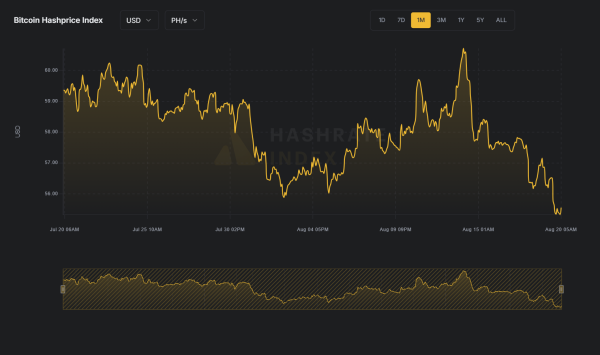Bitcoin, difficulty at 129T: hashprice at $60/PH/s and tariffs at 57.6% challenge the miners

The difficulty of Bitcoin reaches a new all-time high, around 129 trillion, according to updates from August 2025. In parallel, the average hashprice remains close to $60/PH/s (estimates from Hashrate Index), while in the United States, hardware importers for mining face tariffs up to 57.6% on ASICs. A context that tightens margins and forces many operators to rethink their strategies.
During our qualitative monitoring of corporate communications, regulatory reports, and industry articles updated to August 2025, we found that a significant number of operators have revised their investment and procurement plans.
The analysts we consulted indicate that high tariffs and record difficulty make a slowdown in new ASIC orders more likely and a greater focus on operational efficiency. These findings are consistent with the public data and with the independent analyses available in industry literature.
Summary
- Bitcoin Difficulty at 129T: meaning and context
- Hashprice at $60/PH/s: margins under pressure
- Commissions decreasing: fee share below 1% in July 2025
- Tariffs on ASICs at 57.6%: impact on CAPEX and supply chain
- Practical effects of tariffs
- Prospects 2025: break-even, consolidation, and risks
- The moves of the miners: efficiency, hedging, and flexibility
- Impact on the market and scenarios
- Related Insights
- Summary
Bitcoin Difficulty at 129T: meaning and context
The difficulty indicates how “arduous” it is to mine a new block: it increases as the global computing power (hashrate) grows, in order to keep the average time between blocks around 10 minutes. The peak at 129T reflects the entry of more efficient hardware and the expansion of large farms, with direct effects on the unit production costs of each BTC.
In operational terms, a higher difficulty results in lower probabilities that a single hash is winning. In this context, with the BTC price being equal, the revenues per unit of power tend to decrease.
Hashprice at $60/PH/s: margins under pressure
The hashprice is the estimated revenue per unit of hashrate (for example, dollars per PH/s per day). With the difficulty at its peak, the indicator is around $60/PH/s, indicating a more compressed profitability compared to previous phases of the cycle.

The profitability for Bitcoin miners collapses due to tariffs introduced by Donald Trump. Source: Hashrate Index
This results in a compression of margins: miners with high energy costs or with less efficient machines (high consumption in W/TH) are the first to feel the impact. It should be noted that, for many operators, the break-even point shifts upwards, increasing sensitivity to fluctuations in the spot price of BTC.
Commissions decreasing: fee share below 1% in July 2025
In the month of July 2025, the fees accounted for less than 1% of the block revenues. This means that the predominant share of miners’ income comes from the fixed reward (currently equal to 3.125 BTC, consistent with the halving cycle), making cash flows more exposed to changes in difficulty and the spot price.
When the fees remain depressed, the volatility of monthly revenues tends to increase: even small deviations in price or difficulty can significantly impact overall profitability.
Tariffs on ASICs at 57.6%: impact on CAPEX and supply chain
The recent trade tightening in the United States introduces tariffs for importers of mining hardware that can reach up to 57.6%. The effect is a more burdensome CAPEX to renew or expand the machine fleet, with possible logistical delays and greater capital immobilized along the supply chain.
Two recent cases highlight the scope of the issue: CleanSpark reported a potential exposure of up to $185 million, while Iris Energy received a claim in the order of $100 million. Both companies are challenging the demands of the U.S. customs.
Practical effects of tariffs
- Increase in unit cost for the purchase of new ASICs and spare parts
- Delivery times longer and larger stocks to mitigate risks
- Expansion plans reshaped, with increasing focus on energy efficiency per watt
- Contenziosi and accounting uncertainty on potential liabilities
Prospects 2025: break-even, consolidation, and risks
In 2025, the profitability of miners will depend on three central variables: the cost of energy, the network difficulty, and the hashprice. With difficulty at its peak and low fees, the break-even point shifts higher. Possible implications include consolidation of the sector, a slowdown in ASIC orders, and increased relocation to areas with more competitive energy.
A decrease in difficulty or a recovery of the hashprice could offer temporary relief; however, structural factors – persistent tariffs and high energy costs – require deeper strategic responses. An interesting aspect is the different resilience among operators, linked to energy mix and contract structure.
The moves of the miners: efficiency, hedging, and flexibility
- Energy optimization: renewal with more efficient machines, immersion cooling, participation in demand response programs
- Supply chain: diversification of suppliers, nearshoring solutions, and renegotiation of contracts
- Hedging: coverage on BTC and instruments linked to the hashrate (e.g., specialized indices and derivatives, like those offered by Hashrate Index)
- Energy mix: greater share of renewables and use of otherwise wasted energy
Impact on the market and scenarios
The pressure on revenues could trigger a natural selection: operators with high OPEX might reduce activity or divest assets, leaving room for more efficient players. In case of an increase in the BTC price or a decrease in difficulty, margins can improve; however, visibility remains limited until tariffs and energy costs converge to more favorable levels.
Related Insights
- How Bitcoin mining works: hashrate, difficulty, and rewards
- Halving Bitcoin: what changes for miners and for the market
- Bitcoin price today: quotations and market factors
Summary
Summary: difficulty at 129T, hashprice around $60/PH/s, fee share below 1% in July 2025, and tariffs up to 57.6% on ASICs in the USA. The 2025 outlook remains challenging for miners, dealing with compressed margins and increasing CAPEX. The future balance will depend on the price of BTC, the cost of energy, and regulatory developments.
Transparency note: the data presented is based on public and updated sources (Hashrate Index,Blockchain.com Charts,Cambridge Bitcoin Electricity Consumption Index).
 Bitcoin
Bitcoin  Ethereum
Ethereum  Tether
Tether  XRP
XRP  USDC
USDC  Lido Staked Ether
Lido Staked Ether  TRON
TRON  Dogecoin
Dogecoin  Cardano
Cardano  Figure Heloc
Figure Heloc  Bitcoin Cash
Bitcoin Cash  Wrapped stETH
Wrapped stETH  WhiteBIT Coin
WhiteBIT Coin  Wrapped Bitcoin
Wrapped Bitcoin  Wrapped eETH
Wrapped eETH  USDS
USDS  Chainlink
Chainlink  Binance Bridged USDT (BNB Smart Chain)
Binance Bridged USDT (BNB Smart Chain)  Zcash
Zcash  LEO Token
LEO Token  WETH
WETH  Monero
Monero  Stellar
Stellar  Coinbase Wrapped BTC
Coinbase Wrapped BTC  Sui
Sui  Litecoin
Litecoin  Ethena USDe
Ethena USDe  Hyperliquid
Hyperliquid  Avalanche
Avalanche  Hedera
Hedera  Canton
Canton  Shiba Inu
Shiba Inu  World Liberty Financial
World Liberty Financial  sUSDS
sUSDS  Toncoin
Toncoin  USDT0
USDT0  Dai
Dai  Cronos
Cronos  Uniswap
Uniswap  PayPal USD
PayPal USD  Polkadot
Polkadot  Ethena Staked USDe
Ethena Staked USDe  Mantle
Mantle  USD1
USD1  Pepe
Pepe  Rain
Rain  MemeCore
MemeCore  Bittensor
Bittensor  Aave
Aave  Bitget Token
Bitget Token  OKB
OKB  NEAR Protocol
NEAR Protocol  Tether Gold
Tether Gold  Falcon USD
Falcon USD  Ethereum Classic
Ethereum Classic  Ethena
Ethena  Jito Staked SOL
Jito Staked SOL  Binance-Peg WETH
Binance-Peg WETH  Aster
Aster  Internet Computer
Internet Computer  Pi Network
Pi Network  BlackRock USD Institutional Digital Liquidity Fund
BlackRock USD Institutional Digital Liquidity Fund  Wrapped SOL
Wrapped SOL  PAX Gold
PAX Gold  Worldcoin
Worldcoin  HTX DAO
HTX DAO  Jupiter Perpetuals Liquidity Provider Token
Jupiter Perpetuals Liquidity Provider Token  Global Dollar
Global Dollar  Circle USYC
Circle USYC  KuCoin
KuCoin  Midnight
Midnight  Aptos
Aptos  Binance Staked SOL
Binance Staked SOL  Sky
Sky  syrupUSDC
syrupUSDC  Ondo
Ondo  Pump.fun
Pump.fun  Ripple USD
Ripple USD  Rocket Pool ETH
Rocket Pool ETH  BFUSD
BFUSD  Wrapped BNB
Wrapped BNB  POL (ex-MATIC)
POL (ex-MATIC)  Binance Bridged USDC (BNB Smart Chain)
Binance Bridged USDC (BNB Smart Chain)  Arbitrum
Arbitrum  Gate
Gate  Algorand
Algorand  Quant
Quant  Cosmos Hub
Cosmos Hub  Filecoin
Filecoin  MYX Finance
MYX Finance  Official Trump
Official Trump  Render
Render  VeChain
VeChain  Bonk
Bonk  Function FBTC
Function FBTC  Janus Henderson Anemoy AAA CLO Fund
Janus Henderson Anemoy AAA CLO Fund  Bridged Wrapped Lido Staked Ether (Scroll)
Bridged Wrapped Lido Staked Ether (Scroll)  Lombard Staked BTC
Lombard Staked BTC  Solv Protocol BTC
Solv Protocol BTC  NEXO
NEXO  Liquid Staked ETH
Liquid Staked ETH  USDD
USDD  USDtb
USDtb  OUSG
OUSG  Superstate Short Duration U.S. Government Securities Fund (USTB)
Superstate Short Duration U.S. Government Securities Fund (USTB)  Sei
Sei  Pudgy Penguins
Pudgy Penguins  WrappedM by M^0
WrappedM by M^0  Story
Story  Polygon Bridged USDC (Polygon PoS)
Polygon Bridged USDC (Polygon PoS)  Arbitrum Bridged WBTC (Arbitrum One)
Arbitrum Bridged WBTC (Arbitrum One)  Mantle Staked Ether
Mantle Staked Ether  Renzo Restaked ETH
Renzo Restaked ETH  Jupiter
Jupiter  PancakeSwap
PancakeSwap  clBTC
clBTC  syrupUSDT
syrupUSDT  Beldex
Beldex  Ondo US Dollar Yield
Ondo US Dollar Yield  Wrapped Flare
Wrapped Flare  Virtuals Protocol
Virtuals Protocol  Artificial Superintelligence Alliance
Artificial Superintelligence Alliance  Lighter
Lighter  USDai
USDai  StakeWise Staked ETH
StakeWise Staked ETH  Jupiter Staked SOL
Jupiter Staked SOL  Stacks
Stacks  Polygon PoS Bridged DAI (Polygon POS)
Polygon PoS Bridged DAI (Polygon POS)  L2 Standard Bridged WETH (Base)
L2 Standard Bridged WETH (Base)  Curve DAO
Curve DAO  Optimism
Optimism  Kinetiq Staked HYPE
Kinetiq Staked HYPE  SPX6900
SPX6900  Tezos
Tezos  c8ntinuum
c8ntinuum  Dash
Dash  Aerodrome Finance
Aerodrome Finance  tBTC
tBTC  Usual USD
Usual USD  Lido DAO
Lido DAO  FLOKI
FLOKI  Spiko EU T-Bills Money Market Fund
Spiko EU T-Bills Money Market Fund  Arbitrum Bridged WETH (Arbitrum One)
Arbitrum Bridged WETH (Arbitrum One)  Injective
Injective  GTETH
GTETH  Ether.fi
Ether.fi  pippin
pippin  GHO
GHO  TrueUSD
TrueUSD  Celestia
Celestia  Ether.Fi Liquid ETH
Ether.Fi Liquid ETH  Stader ETHx
Stader ETHx  Marinade Staked SOL
Marinade Staked SOL  Chiliz
Chiliz  Starknet
Starknet  Wrapped ApeCoin
Wrapped ApeCoin  DoubleZero
DoubleZero  The Graph
The Graph  IOTA
IOTA  Swell Ethereum
Swell Ethereum  AB
AB  Maple Finance
Maple Finance  BitTorrent
BitTorrent  sBTC
sBTC  Conflux
Conflux  JUST
JUST  Coinbase Wrapped Staked ETH
Coinbase Wrapped Staked ETH  Ethereum Name Service
Ethereum Name Service  Plasma
Plasma  Bitcoin SV
Bitcoin SV  Staked Aave
Staked Aave  dogwifhat
dogwifhat  Steakhouse USDC Morpho Vault
Steakhouse USDC Morpho Vault  Fartcoin
Fartcoin  Telcoin
Telcoin  Pyth Network
Pyth Network  Binance-Peg Dogecoin
Binance-Peg Dogecoin  Sun Token
Sun Token  Trust Wallet
Trust Wallet  Pendle
Pendle  Gnosis
Gnosis  Kaia
Kaia  AINFT
AINFT  EURC
EURC  Avalanche Bridged BTC (Avalanche)
Avalanche Bridged BTC (Avalanche)  Olympus
Olympus  BENQI Liquid Staked AVAX
BENQI Liquid Staked AVAX  Wrapped STX (Velar)
Wrapped STX (Velar)  Basic Attention
Basic Attention 